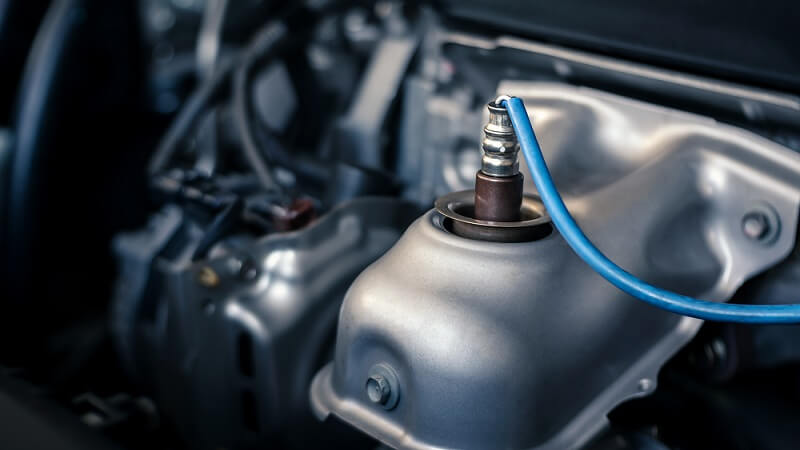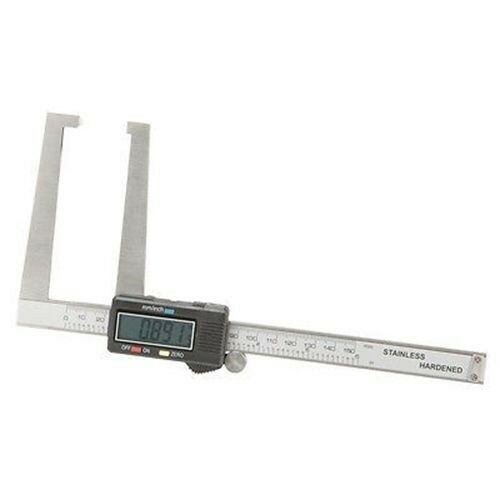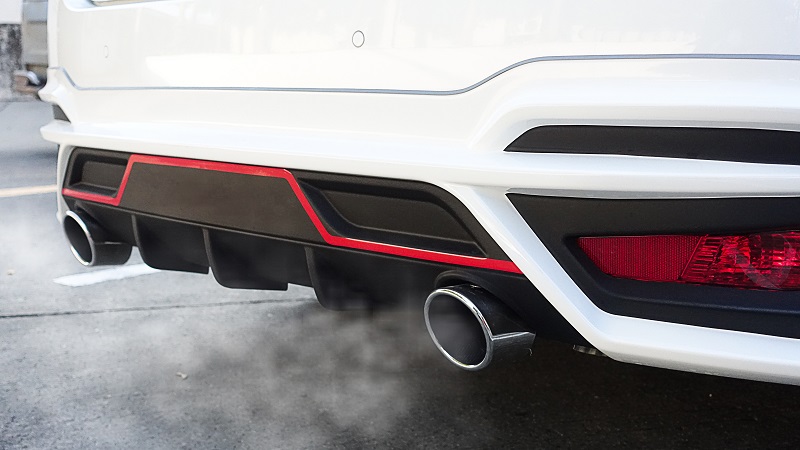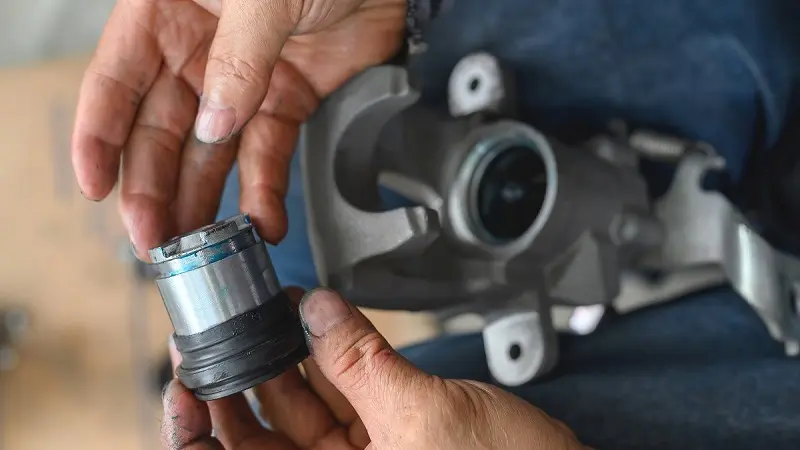The first thought that comes to our mind when we begin noticing weak braking performance is worn brake pads. It’s almost instinctive and for a good reason. After all, 9 times out of 10 most of your braking issues are related to worn pads or worn rotors. However, that 1/10 case could be related to your brake fluid.
Unlike pads and rotors, brake fluid isn’t something that everyone’s familiar with. We’ll do our best to change that today. We’ve put together this guide to help you understand fundamental aspects like the types of brake fluid and brake fluid color while answering some commonly asked questions.

Article updated on 02/08/22. Original publishing date 10/03/21.
What Color is Brake Fluid Supposed to Be?
Brake fluid color is supposed to be clear with a hint of yellow or golden, similar to engine oil. The vast majority of vehicles on the road today use a similar type of brake fluid which gives them the hue. However, certain types of brake fluids come out of the container in a different hue. That’s not all, brake fluid also ages and eventually goes bad, all of which can cause brake fluid color to change.
Types of Brake Fluid
While the types of brake fluid and its properties are a whole other topic by itself, it’s important to get an idea of the basics to better understand brake fluid color.
DOT 3 Brake Fluid Color
While it would have been nice to have a uniform color for each type of fresh brake fluid, that isn’t the case. Manufacturers like making their products distinguishable and because of that fresh DOT 3 brake fluid can be found in clear, yellow, blue, and red shades.
DOT 3 brake fluid has a dry boiling point of 401 °F and a wet boiling point of 284 °F. The one advantage DOT 3 has over DOT 4 is that it will absorb less moisture from the air over time, meaning you’ll need to have your fluid changed less frequently.
DOT 4 Brake Fluid Color
DOT 4 Brake fluid is becoming increasingly common and the most popular pick as it has higher dry (446 °F) and wet boiling points (311 °F), making it safer for higher temperatures.
That’s not all, the widespread use of anti-lock braking systems (ABS) and traction control benefit from DOT 4 fluid’s lower viscosity. The most common color for DOT 4 brake fluid is almost clear with a hint of yellow, but it can also be found in crimson red.
DOT 5 Brake Fluid Color
DOT 5 brake fluid is silicone, meaning it doesn’t absorb water. DOT 5 fluid isn’t compatible with other brake fluid types, and it’s reserved for use in classic vehicles and some military applications.
With DOT 5, vehicles can be stored for long periods without facing water absorption that could cause damage. This brake fluid has a dry and wet boiling point of 500 °F and 356 °F. As for color, DOT 5 brake fluid is usually purple. It’s also important to know that this fluid is not compatible with anti-lock braking systems.
DOT 5.1 Brake Fluid Color
DOT 5.1 brake fluid is available in either clear, yellow or blue. Unlike DOT 5, 5.1 is compatible with DOT 3 and DOT 4 fluid and can be used in conventional applications. DOT 5.1 has one huge advantage over the other brake fluids as it has much higher dry (500 °F) and wet boiling points (356 °F). This makes DOT 5.1 the ideal choice for use in high-performance vehicles and heavy-duty applications.
Bad Brake Fluid
While the brake fluid’s color shades differ quite a bit, they share one similarity and that is to have a clear appearance when it’s fresh. However, if the fluid in your vehicle isn’t and has an unclear brown shade, it needs to be replaced. A darker shade suggests that it’s going bad or just aging due to impurities like dirt and debris, heating, and moisture.
What to Do If Your Brake Fluid Color is Dark?

If your brake fluid color is dark, it needs to be flushed and replaced with fresh fluid that’s compatible with your vehicle. Brake fluid color usually goes darker as it gets old. This mainly occurs because brake fluids are hygroscopic, which means they are designed to absorb water. It won’t just absorb water, but the moisture from that makes its way through rubber brake lines.
As we mentioned before, other contaminants like dirt and debris are also responsible for causing the brake fluid color to go dark. Another big reason for brake fluid color to change is by crossing its boiling points. If your brake fluid color is dark in the reservoir, and you must get it replaced. This procedure involves feeding in fresh brake fluid while bleeding out the bad brake fluid.
Here are the steps to follow if you are doing it yourself:
- Remove the old, contaminated fluid from the master cylinder reservoir using any suction tool. You could use a suction syringe or a turkey blaster.
- Clean out the inside of the reservoir with a microfiber cloth or any clean lint-free cloth.
- Fill fresh brake fluid into the reservoir till it reaches the maximum capacity line and shut the cap. If the cap doesn’t have a snug fit, you should replace it.
- Bleed the brakes at all four ends until you see the clear brake fluid pushing out the darker one out of the system. Make sure to top up the reservoir once all the brake lines have fresh brake fluid.
If you’re changing your brake fluid while running on semi worn pads, keep in mind that you might have to remove some fluid once you replace the pads. Here’s our guide on how to check and add brake fluid should you need to. The brake fluid changes as the pads get worn. When you put new pads on, the caliper piston will retract all the way back, thus increasing the level of brake fluid in the tank.
What Color Is Brake Fluid When It Leaks?
When brake fluid leaks, it is usually brown. If you are someone who makes sure to replace brake fluid at recommended intervals, but still notice mushy or spongy feedback from the brakes, there’s a high probability of a brake fluid leak. Brakes that fade, on the other hand, aren’t a symptom of leaking brake fluid and suggest that the fault lies elsewhere in the braking system.
The first thing to do to check for a brake fluid leak is to look around every component that the fluid passes through. The brake lines and hoses are the first to develop a leak as they are made out of rubber in most vehicles. That being said, components like the calipers and wheel cylinders could also be the source of a brake fluid leak. If you notice moisture around these components or droplets of a brown liquid, it’s brake fluid.
As mentioned above, brake fluid color will change to brown when exposed to impurities. However, if the leak only developed not long after a brake fluid flush, there’s also the likelihood of it still having a lighter shade. However, if you notice brake fluid under your vehicle before giving it an inspection, it can be easily mistaken for engine oil as it has a similar shade. This is why it’s important to pay attention to the feedback from the brake pedal as that combined with the leaking fluid will suggest that the fluid below your vehicle is indeed brake fluid.
Please keep in mind that a brake fluid leak is a major problem and one that has to be addressed at once. While the symptoms that arise early on may not be as severe, with time this could lead to a significant reduction in braking performance.
How Often Should You Change Your Brake Fluid?

You must change your brake fluid at the recommended interval mentioned in your owner’s manual. However, there’s no harm in being safe and doing it more often. Every 2 years or 25,000 miles, whichever comes first, is usually a safe interval to follow. Brake fluid isn’t that expensive and your vehicle doesn’t require a lot of it. There are exactly zero reasons to ignore this important part of regular car maintenance.
If you choose to ignore changing your brake fluid, you won’t just end up with weak braking performance, but also end up damaging braking components. The impure brake fluid that contains contaminants and moisture can cause irreversible damage to expensive components like the master cylinder and calipers.
Are You Looking for Quality Brake Fluid?
To avoid all of that, you should get yourself some fresh brake fluid and ensure that the lifeblood of your brakes is in top shape. Here at Newparts.com, we offer brake fluids made by top-tier brands such as Motul, Brembo, and others. Treat your car with quality brake fluid and enjoy peace of mind knowing that your brakes are ready to stop you on a dime!





